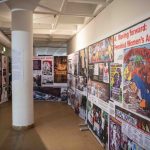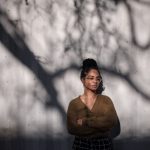Cass Abrahams cooks up a culinary revolution
The food historian and Cape cookery expert’s work in the kitchen since the 1980s remains a touchstone for the cultural and historical value of Cape Muslim cuisine.
Author:
6 September 2019

There is a growing number of prominent cooks, between the Bo-Kaap and the Cape Flats, who pay homage to the food known as Cape Malay or Cape Muslim cuisine, terms steeped in social and political ideology. The cuisine has evolved over more than 350 years since the first slaves and exiles from the East – generally Indonesia and surrounds – arrived in the Cape, irrevocably altering the culinary history of South Africa.
In the 1980s, the kitchen narrative, once the domain of white writers who looked in, shifted into the hands of the slaves’ descendants. Cass Abrahams, 76, a food historian and Cape cookery expert took this a step further in her books and public appearances, unpacking the culture of the Cape Malay people, and many of their “secrets” in a manner that contextualised the cuisine and the customs. Her work remains a touchstone for understanding the community’s culture and culinary record.

Kitchen connections
“Nelson Mandela walked into the kitchen to greet us first,” says Abrahams. “That took the staff by surprise. We were so excited, so touched.”
In the early years after Mandela’s release from Robben Island in 1990, Abrahams was called upon to prepare a Cape Malay dinner for South African businessman and former Pick n Pay chairman Raymond Ackerman and a few Dutch business associates. Mandela was the guest of honour.
She recalls her memories of the former president, as she sits in her family home in Retreat, with a tray of tea and chocolate-dipped butter biscuits – Labarang (the term used in the Cape for Eid) was approaching.
“I remember making tomato bredie, a curry and my potato pudding with glazed fruit preserves that the Dutch call ‘tutti fruiti’,” Abrahams says. “What was memorable was that Mandela, with an impressive stature, came into the kitchen to thank the staff before he went to join other guests.”
It’s a frosty winter day; Abrahams pulls a cigarette from her coat. “You don’t mind?” she asks, lighting up before telling stories about her time travelling around South Africa as a home economist. With her trademark candour and dry sense of humour, she makes you feel as though you’re visiting a favourite aunt.
Related article:
Cashifa (Cass) Abrahams grew up around Newtown, Johannesburg, the daughter of a man with Indian (Tamil-speaking) ancestry and a woman with French and Dutch roots. Her Catholic upbringing saw her attend boarding schools in Tongaat and across Kwa-Zulu Natal. This sense of independence early in life would play a significant role in her ability to navigate her place in the Cape Malay community, the workspace – pre- and postapartheid – and her political identity as a person often caught in the margins of society.
On her deathbed, Abrahams’ mother, Gwendoline Weimers, addressed her Khoekhoen (she had used the term: Hotnot) heritage for the first time.
Years before her mother’s death, Abrahams published Cass Abrahams Cooks Cape Malay: Food from Africa in 1995. It became the first cookbook by a local Muslim author to emphasise the pan-African nature of a cuisine that became profoundly creolised since the first slaves and exiles arrived to work for the Dutch East India Company in the mid-17th century. Her public presentations suggested culinary crossover between the Khoekhoen and the Cape Malays who lived in close proximity.
Historian and poet Gabeba Baderoon in Regarding Muslims: from Slavery to Post-Apartheid says “Abrahams’ signal contribution to food writing in South Africa is to assert the ‘African’ character of Muslim food, to give credit to its African, Asian and creole elements, rather than foregrounding its Asian history”.

A liberation journey
But Abrahams’ journey to food wasn’t straightforward, nor obvious. In the late 1960s, armed with a BSc and studying towards a teacher’s diploma at the University of the Western Cape, she met her now-husband Yusuf (Jowa) Abrahams, a talented rugby player, while hitchhiking.
“I didn’t have any form of transport then, and one day this car stops, and a man asks: ‘Where are you going?’ I said: ‘Where are you going?’ and he says: ‘Anywhere you’re going’. So, I got into the car,” Abrahams says in her customary candid manner. “He was very good looking and I thought: ‘Ooh, good genes. He’s studying at the university as well so he is probably intelligent’, and that was it, I had made up my mind then.”
Facing resistance from both sides, Abrahams married into a Cape Malay family in 1969. She was an outsider, trying to decipher a culture foreign to her. Guided by Oumie, her grandmother-in-law, her repertoire of Cape Malay dishes grew, but not without several trials. Today, those who turned their noses up at the nascent cook’s initial attempts, call her for recipes, she says. The community may have been conservative but Abrahams, supported by her husband, saw her role as a working mother: “It was my goal that I would never be barefoot, pregnant and in front of the stove.”
Related article:
As life would have it, Abrahams did end up in front of the stove by choice for much of her latter career which started when she was 38 and ended with two restaurants, one at the Castle of Good Hope and the other in Paarl. These days, she still hosts private cookery classes from the house in which she has lived most of her married life.
“There’s still a lot of secrecy in the [Cape Malay] community and you must remember I was coloured and married into a staunch family with deep roots in Constantia and the Bo-Kaap,” she says. “I also asked a lot of questions – why this? why that? And often I was told: ‘Because my grandmother did it that way.’” But that didn’t satisfy Abrahams; her dogged persistence meant she was slowly collecting the wisdom behind the mystery – for example, a teaspoon of sugar sprinkled on top of a bredie will balance any bitterness that emerges from cooking.

Beyond the plate
Working as Tastic’s first home economist who was not designated white under apartheid between 1983 and 1989 provided Abrahams a platform to share these “secrets” but also the history and customs of Cape Malay rituals. “Unlike the other women they employed I didn’t really know how to cook, and I made it a requirement of the job – that they teach me how. Secondly, the white women had a fantastic vocabulary of French cookery terms like julienne, sauté and brunoise.” Beyond her two degrees, she felt unsure in this context, she explains.
Restaurateur and author Peter Veldsman, one of her mentors, reiterated that the skills she had were adequate. “By this time I had learned some cooking from Jowa’s grandmother, I knew about layering spices and I thought what I can bring to the table is an education about the culture behind the cuisine,” Abrahams says. From small town church groups to the Vroue Landbou-unie, Abrahams travelled the country extensively, often over weekends too.
“They didn’t know how we baptised our children or what the Quran was about, how we buried our dead and that once niyyat is made, the food offered by the host is the guests’ for the taking. In the workplace they thought we were rude to pack our serviettes because they knew nothing about us,” she says. Thus, she explains how she took the so-called exotic and placed it in the realm of quotidian.
And Abraham’s superpower? “My sense of smell. I can smell if you left something out in one of my dishes, from outside. And I will tell you exactly what it is,” she says.

Legacy tables
After the elections in 1994, Abrahams armed with her first passport was made a culinary ambassador and travelled to France, the US, Germany and Denmark, presenting Xhosa-style samp and beans (“diamonds and pearls”), bobotie and bredies. She extracted the rich essence from the everyday dishes born of paucity.
“For years I had been teaching white representatives how to make Cape Malay dishes that they would replicate for our embassies overseas and get all the credit for. Now, it was my turn. It’s just a pity I didn’t charge the same fees – I’d be sitting pretty today,” she says.
For Abrahams, the task at hand was also remedial – she wanted to set the record straight that South African cuisine was more than braai and European food that the predominantly white male South African Chef’s Association had long punted. “It was an opportunity to represent the country, to undo the sense of shame [white] people associated with our cuisines. For most of my life, I was used to being treated like a second-class citizen. When I cooked our food for people overseas, I was treated with respect and so was our food.”
Related article:
The protest actions before the fall of apartheid was a harrowing time and Abrahams mentioned that tensions rose at home as her then-teenage daughter, Rehane, often returned from riots tear-gassed and smeared in paint. “All our kids were politically active. The conversations were terrible though, I remember pleading with her that she might get killed. She was very radical, she still is. And she yelled: ‘What makes me so special? Remember other people’s children are also dying.’” Abrahams concedes that in a way that gave her comfort and she knows her spirit and determination will live on, in her own daughter.
Today, Rehane Abrahams is the co-conceptualiser, writer and performer of the acclaimed feminist play Womb of Fire, inspired by the idea of matriarchal lineage and suppressed lines of ancestry that has its roots in those final conversations between Abrahams and her mother.
“I don’t know if I have left a legacy, what I do know is I have brought people together. I used to make that my mission to speak to as many women’s groups as possible, across the colour line, the language line, in townships and suburbs alike,” Abrahams says.




